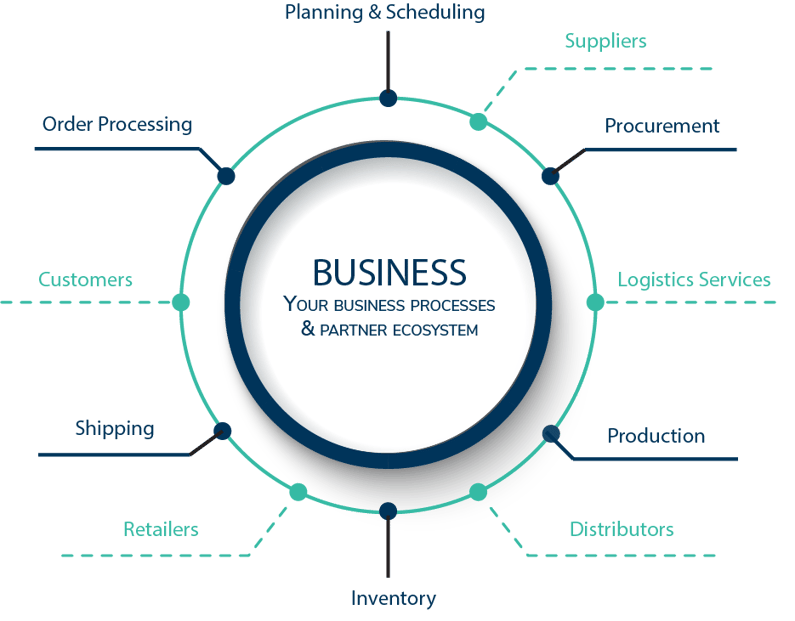Supply chains consist of multiple steps in the value chain, getting a product from raw materials to the end customer. Usually, the supply chain starts with vendors and suppliers. They provide components and raw materials needed to build the product, such as chips for the automotive industry. The following step in the supply chain is producing the product. This step in the value chain converts the raw materials into products that companies are selling. Then finally, distribution comes into play, which can involve multiple different steps and stakeholders. With the huge penetration of e-commerce, these structures are developing and changing constantly. Stakeholders are, for example, wholesalers, retailers, distributors, various logistics service providers, and a variety of internet/mobile based platforms.
We talk about upstream and downstream. Generally, upstream operations are those in which the materials flow into the organization, and downstream operations flow back from the organization to the customers. Aligned with these definitions, logistics plays a vital role in business supply chains. Inbound logistics relate to the upstream part and include the movement prior to manufacturing. Receiving components and materials, storing them, and the actual production phase of the product. As you can expect, outbound logistics are related to the downstream operations involving the movement of the product once it is a finished product, and needs to reach the hands of the end customers.

Procurement and sourcing are crucial elements of the overall process. However, in this blog, our focus excludes those functions, as they support building the foundation of getting the right vendors and suppliers deployed.
The role of the supply chain is very critical; the value chain gives a business a competitive advantage over others. The more value created, the more a customer will want a product, and therefore, the more profit a company will make. The competitive advantage can reside in upstream supply chain and inbound logistics, downstream supply chain and outbound logistics, or even both in an optimal situation. The different strategies rely on adding customer value within different steps of the value chain. The activities of the value chain include inbound logistics, operations, outbound logistics, marketing and sales, and service, per Michael E. Porter, author of Competitive Advantage.
The world is constantly changing at an accelerating pace; hence these key functions require ongoing planning, optimization, analysis, and execution. In today's world, data is the key source of intel on how to optimize and ensure success. This data resides in various locations, inside and outside the company systems. Companies need to have access to it in a usable data format in the right systems that their employees are using.
These important decisions are critical to defining a company's position to become and remain profitable. Decisions need to be made concerning key activities involved in a company's supply chain. The supply chain and logistics create the foundation for the value chain, which is why an end customer chooses a specific company's product over the competition.
Importance of data processing capabilities in this equation
The supply chain is actually a global network of businesses and various business processes, driven by data involved in the production, selling, and distribution of a product, from suppliers that procure raw materials, to end customers through the Internet, OEM, wholesale, and retail outlets as sales channels.

Inefficiencies in the ecosystem, such as component shortages, underutilized plant capacity, excessive inventory, and too high logistics and transportation costs, are caused by inaccurate and/or untimely data, and will probably result in a company making losses and losing market share.
By connecting data between all various stakeholders and IT systems to a platform-based IT system, harmonizing the data, and ensuring its quality and timeliness, companies are on the right track to ensure continuity.
It is not just connecting data flows between endpoints of various IT systems but ensuring the processes are automated, with no human touch needed, and mostly operate flawlessly without interruptions. If those interruptions occur for whatever reason, then they are fixed immediately.
There are lots of details to be considered, such as:
- Agility and rapidity of deployment of the data connectivity
- The flexibility of the platform to adapt to change
- Capability to connect to on-premise and cloud-based systems
- How to execute the processes inside the platform to ensure quality data injection for decision-making processes
- Ensuring you cannot rely on your operational legacy systems to change, as it will take lots of time and money. Your chosen platform needs to adapt to the existing landscape instead.
- A solid plan to integrate/connect old legacy systems with modern ones.
- Where to find the supplier who understands this value chain and the processes related to it.
- Supply chain planning: Systems and solutions that enable demand forecasts for a product, develop sourcing and manufacturing plans for that product, adjust production and distribution plans, and share that information with relevant supply chain network members. One of the most important supply chain planning functions is demand planning, which helps decide the product quantity needed to satisfy customer demand.
- Supply chain execution: Systems and applications manage the physical flows of products through various channels and warehouses to ensure that products are delivered to the right locations efficiently.
The Internet helped transition to partly self-service processes with intranets, extranets, etc. However, those are not automating the processes as they should. To raise the level, companies must get integrated on both data and process levels. In parallel, the number of new applications is increasing daily for various important departmental functions in the value chain. Typically, these providers are cloud-native and offer an API (Application Programming Interface) to integrate with. These also create a challenge: connecting the old data 'standard' based systems to those (e.g., EDI) and ensuring the API integration is supported and works in a business-critical process. APIs also develop and change constantly, just as the world does, and need to change almost daily.
There are innumerable processes that are dependent on timely and accurate information concerning the movements of products through the logistics systems and applications executed by both upstream and downstream companies.
One solid starting point is to start with logistics process integration with your network members, whether these are 3PLs, carriers on various modes, warehouses, etc.
The importance of covering the whole lifecycle of the process (i.e., execution phase) from tendering to invoicing is high. So, why not automate the full flow, instead of just one element of it, such as some regulative data processing or tracking shipments. However, the devil is in the details, and customers know where they should start. Naturally, expert organizations can bring many best practices and recommendations from other industries, regions, and cases, which is one big value of a platform service offering.
Is your company's goal to digitalize your supply chain? Are you torn between buying an iPaaS license and hiring the staff to do all of your supply chain integrations in-house, and buying several Logtech platform products to manage your supply chain execution and visibility processes?
It doesn't have to be either or! The solution is Youredi, the Supply Chain iPaaS vendor that combines the best of both options, including ready ecosystems and ready message formats, and skips drawbacks such as high costs and rigid product roadmaps.
Youredi is the leading provider of fully managed data integration services and solutions for logistics and the global supply chain. Youredi enables customers to scale their business and automation needs through its unified and modern platform for API and EDI transactions. Besides technology, Youredi understands your business needs. Youredi's solutions are versatile, secure, reliable, and available as a fully managed integration service. Youredi enables quick data connectivity and process integration between trading partners of any size. Integrating with ecosystems, carriers, shippers, consignees, and the systems they use, Youredi provides scale, speed, and agility for the global market. A seamless and timely flow of 100 percent accurate data allows organizations to analyze and optimize all their supply chain processes. Youredi operates globally from Finland, the Netherlands, and the United States.
Do you want to learn more about Youredi or the solution we provide? Or perhaps you have an integration challenge to discuss? Click this link to schedule an online meeting with our integration experts, who will gladly walk you through our technology and answer any questions.


